Literature Review: Alternatives to Conventional Asset Valuation Models
VerifiedAdded on 2023/04/21
|19
|5537
|309
Literature Review
AI Summary
This literature review critically examines alternatives to conventional asset valuation models, exploring their effectiveness and applicability in modern finance. It begins by defining alternative investments and contrasting them with traditional asset classes like stocks and bonds. The review analyzes research measures for valuing assets, entities, and opportunities, highlighting the limitations of conventional discounted cash flow models and option pricing models, particularly the Black-Scholes model. It identifies gaps in current option pricing models, such as their reliance on economic space and challenges in modeling risk. The review further explores the application of alternative methods to solve common option pricing problems, emphasizing the need for improved risk assessment and econometric data. It also discusses the role of asset-based valuation approaches, especially for start-ups and asset-heavy businesses, and the importance of considering intangible assets and market conditions. The review concludes by advocating for a more nuanced and adaptive approach to asset valuation, incorporating alternative models to address the shortcomings of conventional methods.
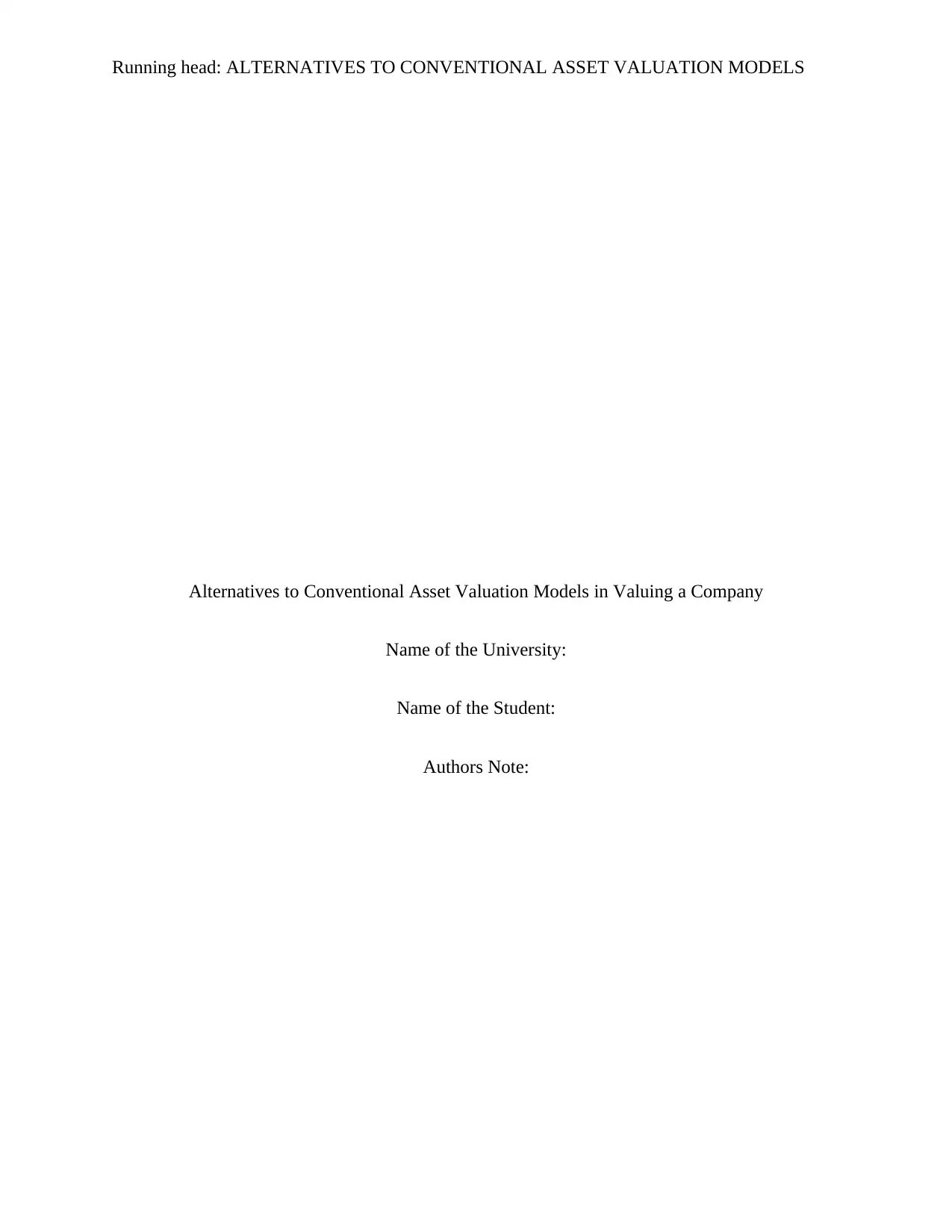
Running head: ALTERNATIVES TO CONVENTIONAL ASSET VALUATION MODELS
Alternatives to Conventional Asset Valuation Models in Valuing a Company
Name of the University:
Name of the Student:
Authors Note:
Alternatives to Conventional Asset Valuation Models in Valuing a Company
Name of the University:
Name of the Student:
Authors Note:
Paraphrase This Document
Need a fresh take? Get an instant paraphrase of this document with our AI Paraphraser
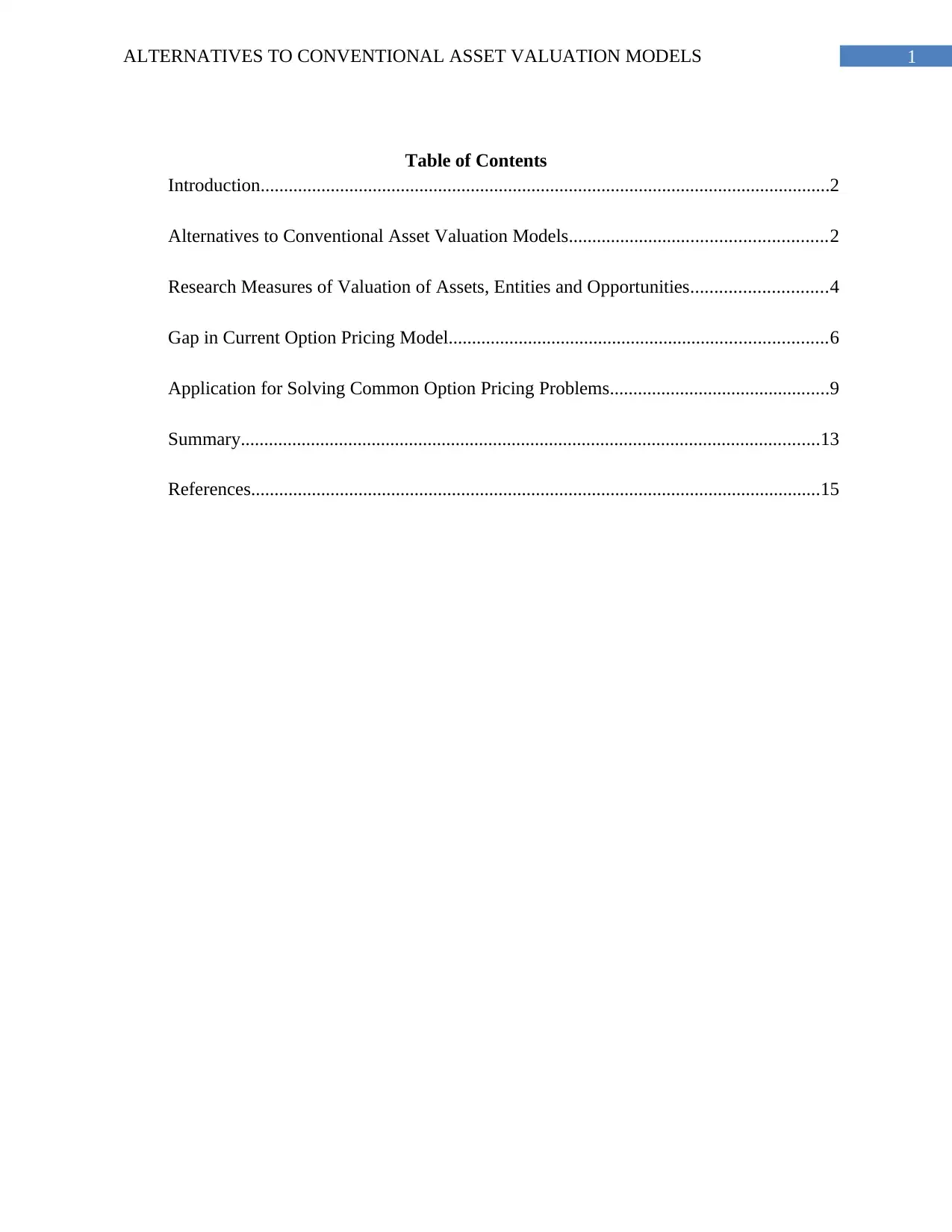
1ALTERNATIVES TO CONVENTIONAL ASSET VALUATION MODELS
Table of Contents
Introduction..........................................................................................................................2
Alternatives to Conventional Asset Valuation Models.......................................................2
Research Measures of Valuation of Assets, Entities and Opportunities.............................4
Gap in Current Option Pricing Model.................................................................................6
Application for Solving Common Option Pricing Problems...............................................9
Summary............................................................................................................................13
References..........................................................................................................................15
Table of Contents
Introduction..........................................................................................................................2
Alternatives to Conventional Asset Valuation Models.......................................................2
Research Measures of Valuation of Assets, Entities and Opportunities.............................4
Gap in Current Option Pricing Model.................................................................................6
Application for Solving Common Option Pricing Problems...............................................9
Summary............................................................................................................................13
References..........................................................................................................................15
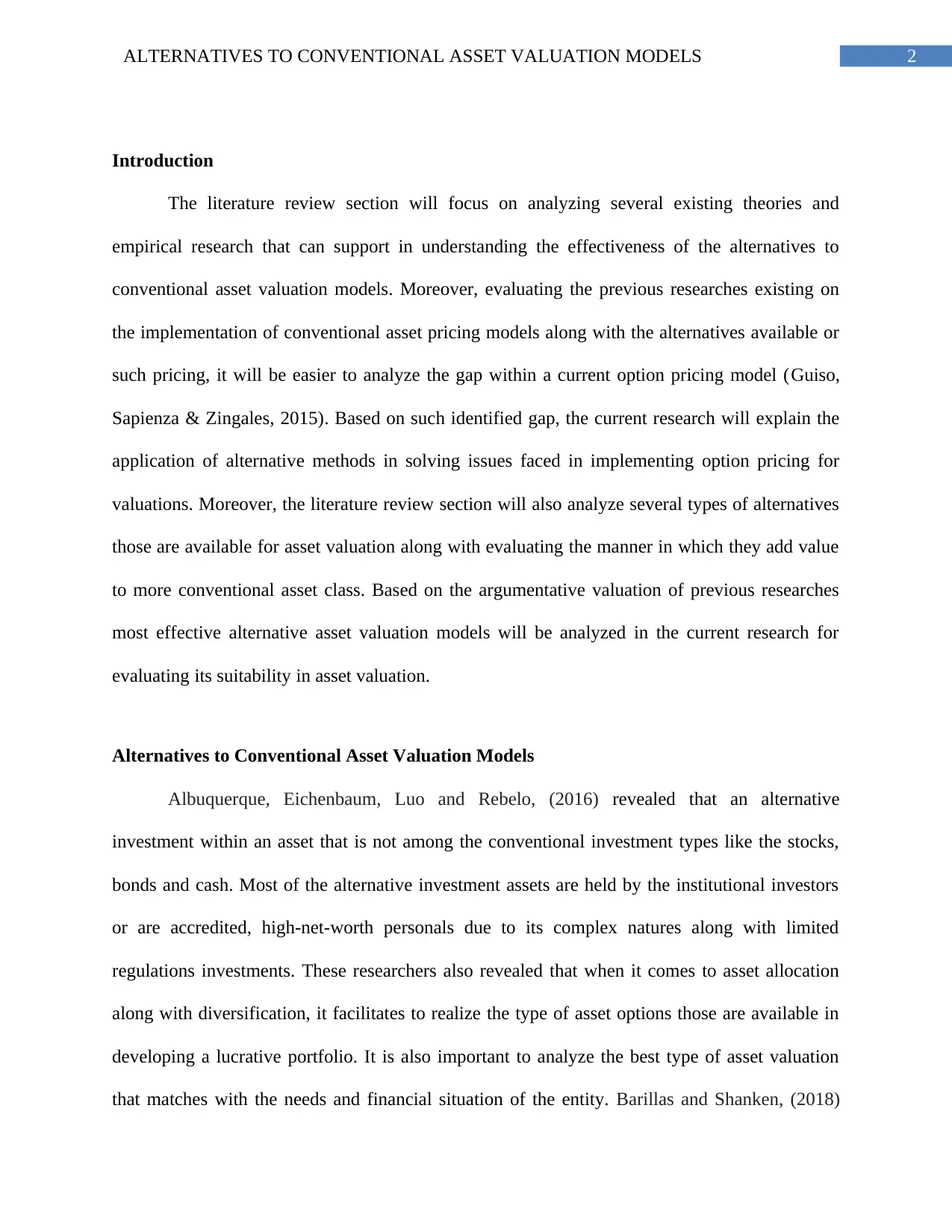
2ALTERNATIVES TO CONVENTIONAL ASSET VALUATION MODELS
Introduction
The literature review section will focus on analyzing several existing theories and
empirical research that can support in understanding the effectiveness of the alternatives to
conventional asset valuation models. Moreover, evaluating the previous researches existing on
the implementation of conventional asset pricing models along with the alternatives available or
such pricing, it will be easier to analyze the gap within a current option pricing model (Guiso,
Sapienza & Zingales, 2015). Based on such identified gap, the current research will explain the
application of alternative methods in solving issues faced in implementing option pricing for
valuations. Moreover, the literature review section will also analyze several types of alternatives
those are available for asset valuation along with evaluating the manner in which they add value
to more conventional asset class. Based on the argumentative valuation of previous researches
most effective alternative asset valuation models will be analyzed in the current research for
evaluating its suitability in asset valuation.
Alternatives to Conventional Asset Valuation Models
Albuquerque, Eichenbaum, Luo and Rebelo, (2016) revealed that an alternative
investment within an asset that is not among the conventional investment types like the stocks,
bonds and cash. Most of the alternative investment assets are held by the institutional investors
or are accredited, high-net-worth personals due to its complex natures along with limited
regulations investments. These researchers also revealed that when it comes to asset allocation
along with diversification, it facilitates to realize the type of asset options those are available in
developing a lucrative portfolio. It is also important to analyze the best type of asset valuation
that matches with the needs and financial situation of the entity. Barillas and Shanken, (2018)
Introduction
The literature review section will focus on analyzing several existing theories and
empirical research that can support in understanding the effectiveness of the alternatives to
conventional asset valuation models. Moreover, evaluating the previous researches existing on
the implementation of conventional asset pricing models along with the alternatives available or
such pricing, it will be easier to analyze the gap within a current option pricing model (Guiso,
Sapienza & Zingales, 2015). Based on such identified gap, the current research will explain the
application of alternative methods in solving issues faced in implementing option pricing for
valuations. Moreover, the literature review section will also analyze several types of alternatives
those are available for asset valuation along with evaluating the manner in which they add value
to more conventional asset class. Based on the argumentative valuation of previous researches
most effective alternative asset valuation models will be analyzed in the current research for
evaluating its suitability in asset valuation.
Alternatives to Conventional Asset Valuation Models
Albuquerque, Eichenbaum, Luo and Rebelo, (2016) revealed that an alternative
investment within an asset that is not among the conventional investment types like the stocks,
bonds and cash. Most of the alternative investment assets are held by the institutional investors
or are accredited, high-net-worth personals due to its complex natures along with limited
regulations investments. These researchers also revealed that when it comes to asset allocation
along with diversification, it facilitates to realize the type of asset options those are available in
developing a lucrative portfolio. It is also important to analyze the best type of asset valuation
that matches with the needs and financial situation of the entity. Barillas and Shanken, (2018)
⊘ This is a preview!⊘
Do you want full access?
Subscribe today to unlock all pages.

Trusted by 1+ million students worldwide
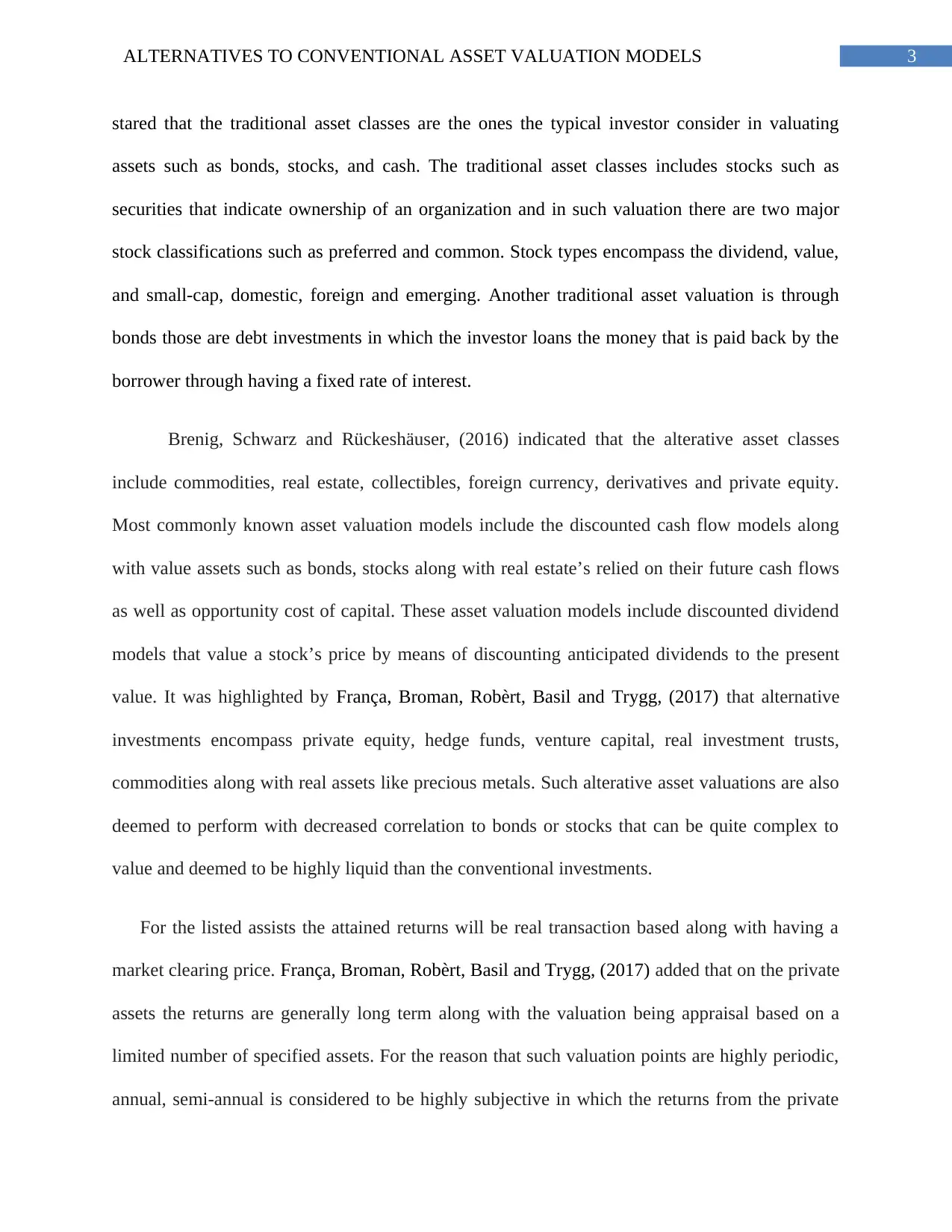
3ALTERNATIVES TO CONVENTIONAL ASSET VALUATION MODELS
stared that the traditional asset classes are the ones the typical investor consider in valuating
assets such as bonds, stocks, and cash. The traditional asset classes includes stocks such as
securities that indicate ownership of an organization and in such valuation there are two major
stock classifications such as preferred and common. Stock types encompass the dividend, value,
and small-cap, domestic, foreign and emerging. Another traditional asset valuation is through
bonds those are debt investments in which the investor loans the money that is paid back by the
borrower through having a fixed rate of interest.
Brenig, Schwarz and Rückeshäuser, (2016) indicated that the alterative asset classes
include commodities, real estate, collectibles, foreign currency, derivatives and private equity.
Most commonly known asset valuation models include the discounted cash flow models along
with value assets such as bonds, stocks along with real estate’s relied on their future cash flows
as well as opportunity cost of capital. These asset valuation models include discounted dividend
models that value a stock’s price by means of discounting anticipated dividends to the present
value. It was highlighted by França, Broman, Robèrt, Basil and Trygg, (2017) that alternative
investments encompass private equity, hedge funds, venture capital, real investment trusts,
commodities along with real assets like precious metals. Such alterative asset valuations are also
deemed to perform with decreased correlation to bonds or stocks that can be quite complex to
value and deemed to be highly liquid than the conventional investments.
For the listed assists the attained returns will be real transaction based along with having a
market clearing price. França, Broman, Robèrt, Basil and Trygg, (2017) added that on the private
assets the returns are generally long term along with the valuation being appraisal based on a
limited number of specified assets. For the reason that such valuation points are highly periodic,
annual, semi-annual is considered to be highly subjective in which the returns from the private
stared that the traditional asset classes are the ones the typical investor consider in valuating
assets such as bonds, stocks, and cash. The traditional asset classes includes stocks such as
securities that indicate ownership of an organization and in such valuation there are two major
stock classifications such as preferred and common. Stock types encompass the dividend, value,
and small-cap, domestic, foreign and emerging. Another traditional asset valuation is through
bonds those are debt investments in which the investor loans the money that is paid back by the
borrower through having a fixed rate of interest.
Brenig, Schwarz and Rückeshäuser, (2016) indicated that the alterative asset classes
include commodities, real estate, collectibles, foreign currency, derivatives and private equity.
Most commonly known asset valuation models include the discounted cash flow models along
with value assets such as bonds, stocks along with real estate’s relied on their future cash flows
as well as opportunity cost of capital. These asset valuation models include discounted dividend
models that value a stock’s price by means of discounting anticipated dividends to the present
value. It was highlighted by França, Broman, Robèrt, Basil and Trygg, (2017) that alternative
investments encompass private equity, hedge funds, venture capital, real investment trusts,
commodities along with real assets like precious metals. Such alterative asset valuations are also
deemed to perform with decreased correlation to bonds or stocks that can be quite complex to
value and deemed to be highly liquid than the conventional investments.
For the listed assists the attained returns will be real transaction based along with having a
market clearing price. França, Broman, Robèrt, Basil and Trygg, (2017) added that on the private
assets the returns are generally long term along with the valuation being appraisal based on a
limited number of specified assets. For the reason that such valuation points are highly periodic,
annual, semi-annual is considered to be highly subjective in which the returns from the private
Paraphrase This Document
Need a fresh take? Get an instant paraphrase of this document with our AI Paraphraser
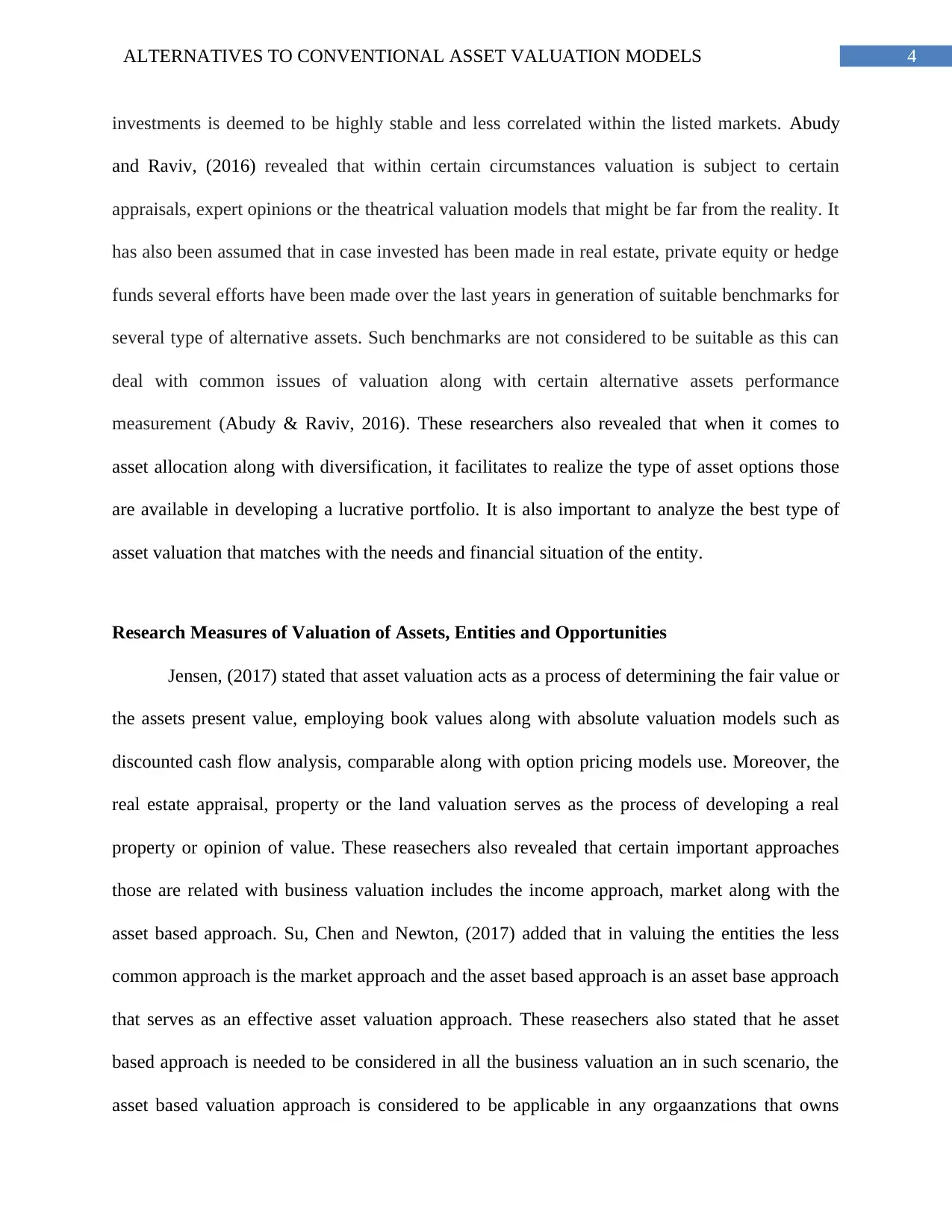
4ALTERNATIVES TO CONVENTIONAL ASSET VALUATION MODELS
investments is deemed to be highly stable and less correlated within the listed markets. Abudy
and Raviv, (2016) revealed that within certain circumstances valuation is subject to certain
appraisals, expert opinions or the theatrical valuation models that might be far from the reality. It
has also been assumed that in case invested has been made in real estate, private equity or hedge
funds several efforts have been made over the last years in generation of suitable benchmarks for
several type of alternative assets. Such benchmarks are not considered to be suitable as this can
deal with common issues of valuation along with certain alternative assets performance
measurement (Abudy & Raviv, 2016). These researchers also revealed that when it comes to
asset allocation along with diversification, it facilitates to realize the type of asset options those
are available in developing a lucrative portfolio. It is also important to analyze the best type of
asset valuation that matches with the needs and financial situation of the entity.
Research Measures of Valuation of Assets, Entities and Opportunities
Jensen, (2017) stated that asset valuation acts as a process of determining the fair value or
the assets present value, employing book values along with absolute valuation models such as
discounted cash flow analysis, comparable along with option pricing models use. Moreover, the
real estate appraisal, property or the land valuation serves as the process of developing a real
property or opinion of value. These reasechers also revealed that certain important approaches
those are related with business valuation includes the income approach, market along with the
asset based approach. Su, Chen and Newton, (2017) added that in valuing the entities the less
common approach is the market approach and the asset based approach is an asset base approach
that serves as an effective asset valuation approach. These reasechers also stated that he asset
based approach is needed to be considered in all the business valuation an in such scenario, the
asset based valuation approach is considered to be applicable in any orgaanzations that owns
investments is deemed to be highly stable and less correlated within the listed markets. Abudy
and Raviv, (2016) revealed that within certain circumstances valuation is subject to certain
appraisals, expert opinions or the theatrical valuation models that might be far from the reality. It
has also been assumed that in case invested has been made in real estate, private equity or hedge
funds several efforts have been made over the last years in generation of suitable benchmarks for
several type of alternative assets. Such benchmarks are not considered to be suitable as this can
deal with common issues of valuation along with certain alternative assets performance
measurement (Abudy & Raviv, 2016). These researchers also revealed that when it comes to
asset allocation along with diversification, it facilitates to realize the type of asset options those
are available in developing a lucrative portfolio. It is also important to analyze the best type of
asset valuation that matches with the needs and financial situation of the entity.
Research Measures of Valuation of Assets, Entities and Opportunities
Jensen, (2017) stated that asset valuation acts as a process of determining the fair value or
the assets present value, employing book values along with absolute valuation models such as
discounted cash flow analysis, comparable along with option pricing models use. Moreover, the
real estate appraisal, property or the land valuation serves as the process of developing a real
property or opinion of value. These reasechers also revealed that certain important approaches
those are related with business valuation includes the income approach, market along with the
asset based approach. Su, Chen and Newton, (2017) added that in valuing the entities the less
common approach is the market approach and the asset based approach is an asset base approach
that serves as an effective asset valuation approach. These reasechers also stated that he asset
based approach is needed to be considered in all the business valuation an in such scenario, the
asset based valuation approach is considered to be applicable in any orgaanzations that owns
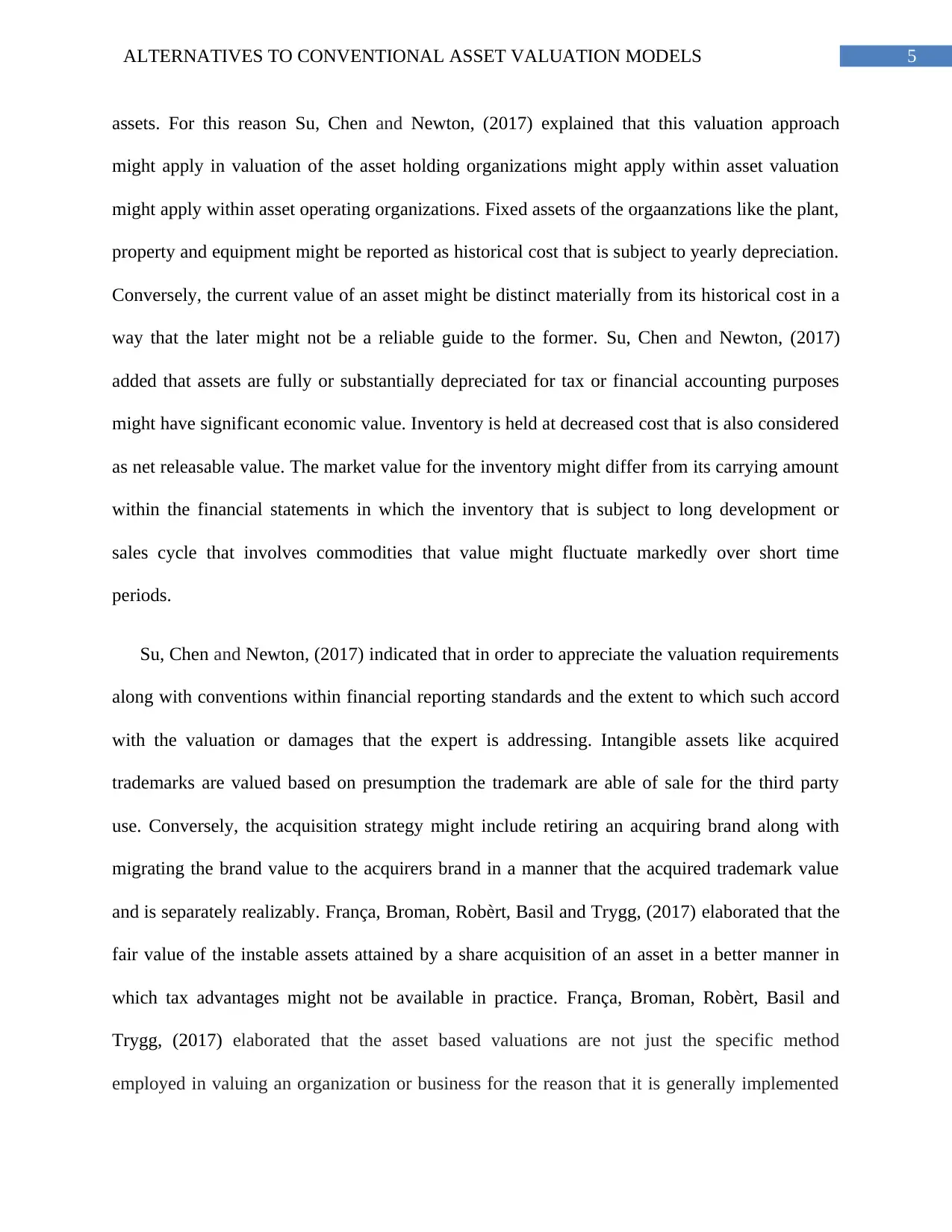
5ALTERNATIVES TO CONVENTIONAL ASSET VALUATION MODELS
assets. For this reason Su, Chen and Newton, (2017) explained that this valuation approach
might apply in valuation of the asset holding organizations might apply within asset valuation
might apply within asset operating organizations. Fixed assets of the orgaanzations like the plant,
property and equipment might be reported as historical cost that is subject to yearly depreciation.
Conversely, the current value of an asset might be distinct materially from its historical cost in a
way that the later might not be a reliable guide to the former. Su, Chen and Newton, (2017)
added that assets are fully or substantially depreciated for tax or financial accounting purposes
might have significant economic value. Inventory is held at decreased cost that is also considered
as net releasable value. The market value for the inventory might differ from its carrying amount
within the financial statements in which the inventory that is subject to long development or
sales cycle that involves commodities that value might fluctuate markedly over short time
periods.
Su, Chen and Newton, (2017) indicated that in order to appreciate the valuation requirements
along with conventions within financial reporting standards and the extent to which such accord
with the valuation or damages that the expert is addressing. Intangible assets like acquired
trademarks are valued based on presumption the trademark are able of sale for the third party
use. Conversely, the acquisition strategy might include retiring an acquiring brand along with
migrating the brand value to the acquirers brand in a manner that the acquired trademark value
and is separately realizably. França, Broman, Robèrt, Basil and Trygg, (2017) elaborated that the
fair value of the instable assets attained by a share acquisition of an asset in a better manner in
which tax advantages might not be available in practice. França, Broman, Robèrt, Basil and
Trygg, (2017) elaborated that the asset based valuations are not just the specific method
employed in valuing an organization or business for the reason that it is generally implemented
assets. For this reason Su, Chen and Newton, (2017) explained that this valuation approach
might apply in valuation of the asset holding organizations might apply within asset valuation
might apply within asset operating organizations. Fixed assets of the orgaanzations like the plant,
property and equipment might be reported as historical cost that is subject to yearly depreciation.
Conversely, the current value of an asset might be distinct materially from its historical cost in a
way that the later might not be a reliable guide to the former. Su, Chen and Newton, (2017)
added that assets are fully or substantially depreciated for tax or financial accounting purposes
might have significant economic value. Inventory is held at decreased cost that is also considered
as net releasable value. The market value for the inventory might differ from its carrying amount
within the financial statements in which the inventory that is subject to long development or
sales cycle that involves commodities that value might fluctuate markedly over short time
periods.
Su, Chen and Newton, (2017) indicated that in order to appreciate the valuation requirements
along with conventions within financial reporting standards and the extent to which such accord
with the valuation or damages that the expert is addressing. Intangible assets like acquired
trademarks are valued based on presumption the trademark are able of sale for the third party
use. Conversely, the acquisition strategy might include retiring an acquiring brand along with
migrating the brand value to the acquirers brand in a manner that the acquired trademark value
and is separately realizably. França, Broman, Robèrt, Basil and Trygg, (2017) elaborated that the
fair value of the instable assets attained by a share acquisition of an asset in a better manner in
which tax advantages might not be available in practice. França, Broman, Robèrt, Basil and
Trygg, (2017) elaborated that the asset based valuations are not just the specific method
employed in valuing an organization or business for the reason that it is generally implemented
⊘ This is a preview!⊘
Do you want full access?
Subscribe today to unlock all pages.

Trusted by 1+ million students worldwide
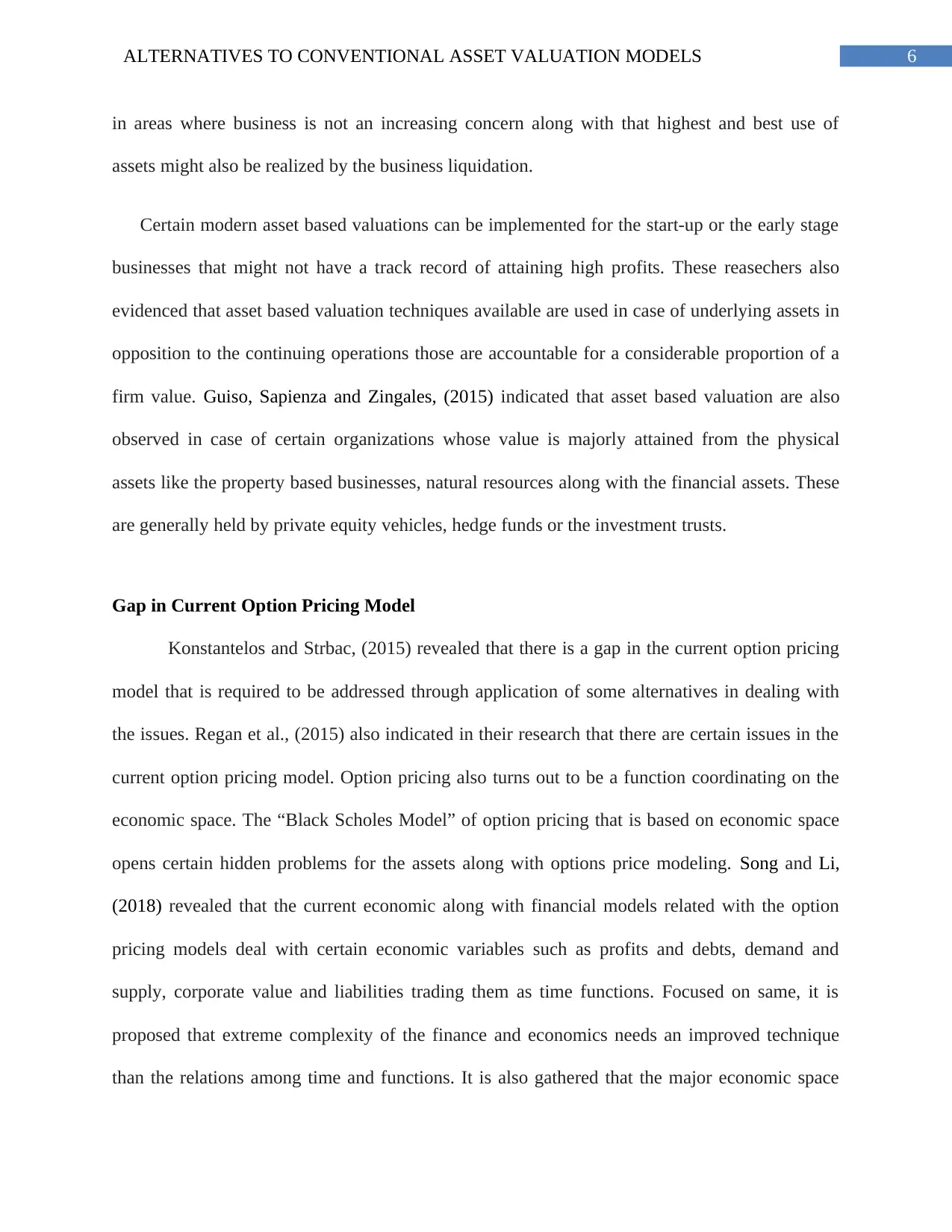
6ALTERNATIVES TO CONVENTIONAL ASSET VALUATION MODELS
in areas where business is not an increasing concern along with that highest and best use of
assets might also be realized by the business liquidation.
Certain modern asset based valuations can be implemented for the start-up or the early stage
businesses that might not have a track record of attaining high profits. These reasechers also
evidenced that asset based valuation techniques available are used in case of underlying assets in
opposition to the continuing operations those are accountable for a considerable proportion of a
firm value. Guiso, Sapienza and Zingales, (2015) indicated that asset based valuation are also
observed in case of certain organizations whose value is majorly attained from the physical
assets like the property based businesses, natural resources along with the financial assets. These
are generally held by private equity vehicles, hedge funds or the investment trusts.
Gap in Current Option Pricing Model
Konstantelos and Strbac, (2015) revealed that there is a gap in the current option pricing
model that is required to be addressed through application of some alternatives in dealing with
the issues. Regan et al., (2015) also indicated in their research that there are certain issues in the
current option pricing model. Option pricing also turns out to be a function coordinating on the
economic space. The “Black Scholes Model” of option pricing that is based on economic space
opens certain hidden problems for the assets along with options price modeling. Song and Li,
(2018) revealed that the current economic along with financial models related with the option
pricing models deal with certain economic variables such as profits and debts, demand and
supply, corporate value and liabilities trading them as time functions. Focused on same, it is
proposed that extreme complexity of the finance and economics needs an improved technique
than the relations among time and functions. It is also gathered that the major economic space
in areas where business is not an increasing concern along with that highest and best use of
assets might also be realized by the business liquidation.
Certain modern asset based valuations can be implemented for the start-up or the early stage
businesses that might not have a track record of attaining high profits. These reasechers also
evidenced that asset based valuation techniques available are used in case of underlying assets in
opposition to the continuing operations those are accountable for a considerable proportion of a
firm value. Guiso, Sapienza and Zingales, (2015) indicated that asset based valuation are also
observed in case of certain organizations whose value is majorly attained from the physical
assets like the property based businesses, natural resources along with the financial assets. These
are generally held by private equity vehicles, hedge funds or the investment trusts.
Gap in Current Option Pricing Model
Konstantelos and Strbac, (2015) revealed that there is a gap in the current option pricing
model that is required to be addressed through application of some alternatives in dealing with
the issues. Regan et al., (2015) also indicated in their research that there are certain issues in the
current option pricing model. Option pricing also turns out to be a function coordinating on the
economic space. The “Black Scholes Model” of option pricing that is based on economic space
opens certain hidden problems for the assets along with options price modeling. Song and Li,
(2018) revealed that the current economic along with financial models related with the option
pricing models deal with certain economic variables such as profits and debts, demand and
supply, corporate value and liabilities trading them as time functions. Focused on same, it is
proposed that extreme complexity of the finance and economics needs an improved technique
than the relations among time and functions. It is also gathered that the major economic space
Paraphrase This Document
Need a fresh take? Get an instant paraphrase of this document with our AI Paraphraser
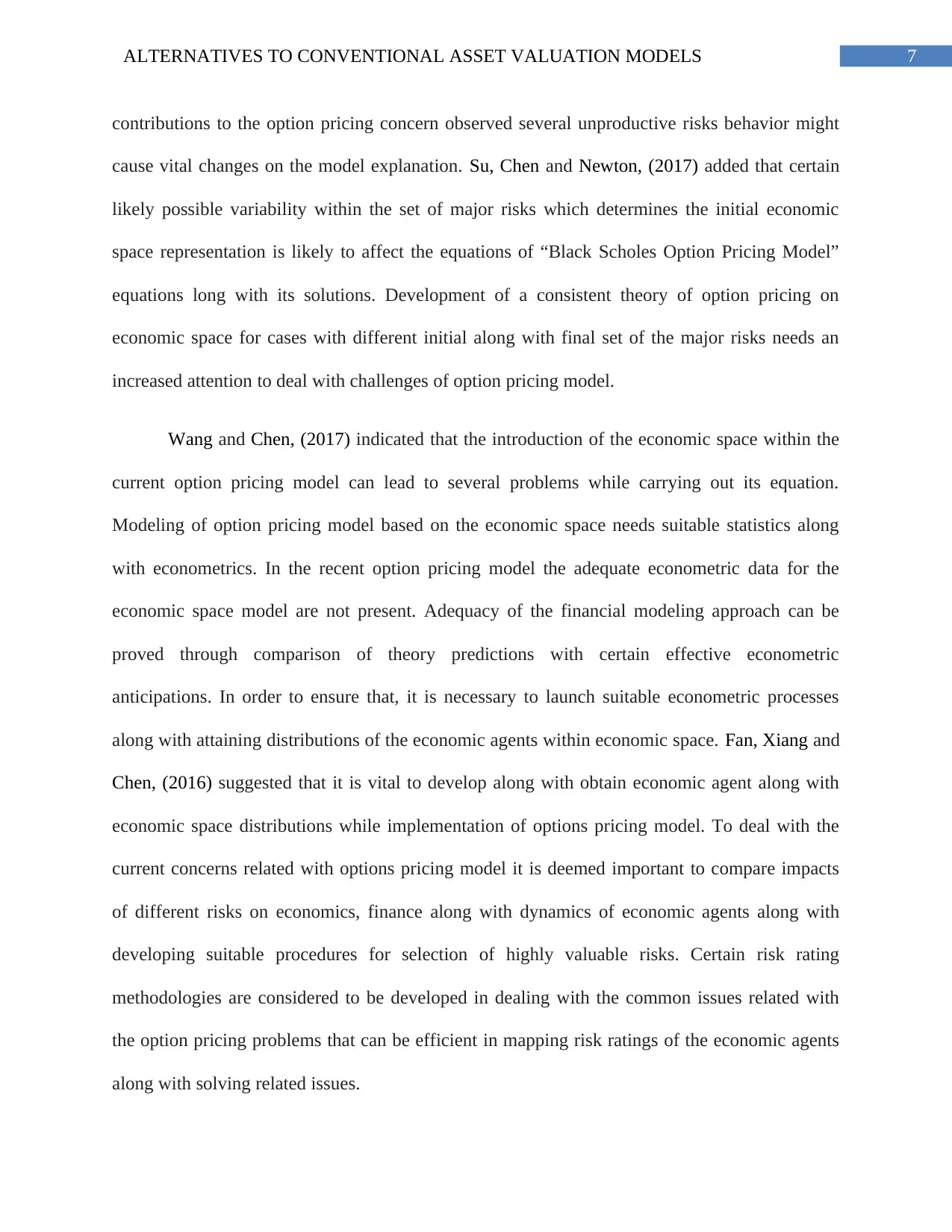
7ALTERNATIVES TO CONVENTIONAL ASSET VALUATION MODELS
contributions to the option pricing concern observed several unproductive risks behavior might
cause vital changes on the model explanation. Su, Chen and Newton, (2017) added that certain
likely possible variability within the set of major risks which determines the initial economic
space representation is likely to affect the equations of “Black Scholes Option Pricing Model”
equations long with its solutions. Development of a consistent theory of option pricing on
economic space for cases with different initial along with final set of the major risks needs an
increased attention to deal with challenges of option pricing model.
Wang and Chen, (2017) indicated that the introduction of the economic space within the
current option pricing model can lead to several problems while carrying out its equation.
Modeling of option pricing model based on the economic space needs suitable statistics along
with econometrics. In the recent option pricing model the adequate econometric data for the
economic space model are not present. Adequacy of the financial modeling approach can be
proved through comparison of theory predictions with certain effective econometric
anticipations. In order to ensure that, it is necessary to launch suitable econometric processes
along with attaining distributions of the economic agents within economic space. Fan, Xiang and
Chen, (2016) suggested that it is vital to develop along with obtain economic agent along with
economic space distributions while implementation of options pricing model. To deal with the
current concerns related with options pricing model it is deemed important to compare impacts
of different risks on economics, finance along with dynamics of economic agents along with
developing suitable procedures for selection of highly valuable risks. Certain risk rating
methodologies are considered to be developed in dealing with the common issues related with
the option pricing problems that can be efficient in mapping risk ratings of the economic agents
along with solving related issues.
contributions to the option pricing concern observed several unproductive risks behavior might
cause vital changes on the model explanation. Su, Chen and Newton, (2017) added that certain
likely possible variability within the set of major risks which determines the initial economic
space representation is likely to affect the equations of “Black Scholes Option Pricing Model”
equations long with its solutions. Development of a consistent theory of option pricing on
economic space for cases with different initial along with final set of the major risks needs an
increased attention to deal with challenges of option pricing model.
Wang and Chen, (2017) indicated that the introduction of the economic space within the
current option pricing model can lead to several problems while carrying out its equation.
Modeling of option pricing model based on the economic space needs suitable statistics along
with econometrics. In the recent option pricing model the adequate econometric data for the
economic space model are not present. Adequacy of the financial modeling approach can be
proved through comparison of theory predictions with certain effective econometric
anticipations. In order to ensure that, it is necessary to launch suitable econometric processes
along with attaining distributions of the economic agents within economic space. Fan, Xiang and
Chen, (2016) suggested that it is vital to develop along with obtain economic agent along with
economic space distributions while implementation of options pricing model. To deal with the
current concerns related with options pricing model it is deemed important to compare impacts
of different risks on economics, finance along with dynamics of economic agents along with
developing suitable procedures for selection of highly valuable risks. Certain risk rating
methodologies are considered to be developed in dealing with the common issues related with
the option pricing problems that can be efficient in mapping risk ratings of the economic agents
along with solving related issues.
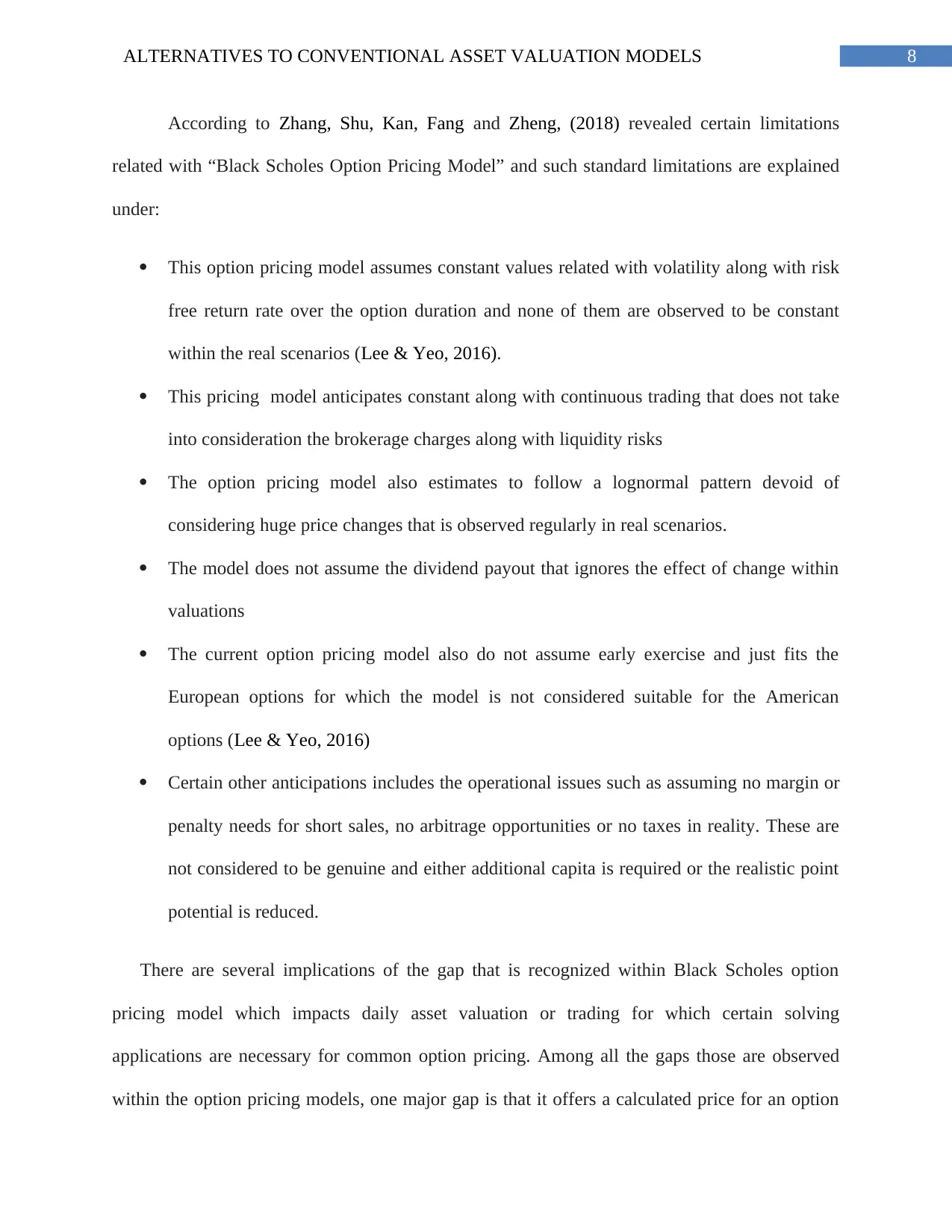
8ALTERNATIVES TO CONVENTIONAL ASSET VALUATION MODELS
According to Zhang, Shu, Kan, Fang and Zheng, (2018) revealed certain limitations
related with “Black Scholes Option Pricing Model” and such standard limitations are explained
under:
This option pricing model assumes constant values related with volatility along with risk
free return rate over the option duration and none of them are observed to be constant
within the real scenarios (Lee & Yeo, 2016).
This pricing model anticipates constant along with continuous trading that does not take
into consideration the brokerage charges along with liquidity risks
The option pricing model also estimates to follow a lognormal pattern devoid of
considering huge price changes that is observed regularly in real scenarios.
The model does not assume the dividend payout that ignores the effect of change within
valuations
The current option pricing model also do not assume early exercise and just fits the
European options for which the model is not considered suitable for the American
options (Lee & Yeo, 2016)
Certain other anticipations includes the operational issues such as assuming no margin or
penalty needs for short sales, no arbitrage opportunities or no taxes in reality. These are
not considered to be genuine and either additional capita is required or the realistic point
potential is reduced.
There are several implications of the gap that is recognized within Black Scholes option
pricing model which impacts daily asset valuation or trading for which certain solving
applications are necessary for common option pricing. Among all the gaps those are observed
within the option pricing models, one major gap is that it offers a calculated price for an option
According to Zhang, Shu, Kan, Fang and Zheng, (2018) revealed certain limitations
related with “Black Scholes Option Pricing Model” and such standard limitations are explained
under:
This option pricing model assumes constant values related with volatility along with risk
free return rate over the option duration and none of them are observed to be constant
within the real scenarios (Lee & Yeo, 2016).
This pricing model anticipates constant along with continuous trading that does not take
into consideration the brokerage charges along with liquidity risks
The option pricing model also estimates to follow a lognormal pattern devoid of
considering huge price changes that is observed regularly in real scenarios.
The model does not assume the dividend payout that ignores the effect of change within
valuations
The current option pricing model also do not assume early exercise and just fits the
European options for which the model is not considered suitable for the American
options (Lee & Yeo, 2016)
Certain other anticipations includes the operational issues such as assuming no margin or
penalty needs for short sales, no arbitrage opportunities or no taxes in reality. These are
not considered to be genuine and either additional capita is required or the realistic point
potential is reduced.
There are several implications of the gap that is recognized within Black Scholes option
pricing model which impacts daily asset valuation or trading for which certain solving
applications are necessary for common option pricing. Among all the gaps those are observed
within the option pricing models, one major gap is that it offers a calculated price for an option
⊘ This is a preview!⊘
Do you want full access?
Subscribe today to unlock all pages.

Trusted by 1+ million students worldwide
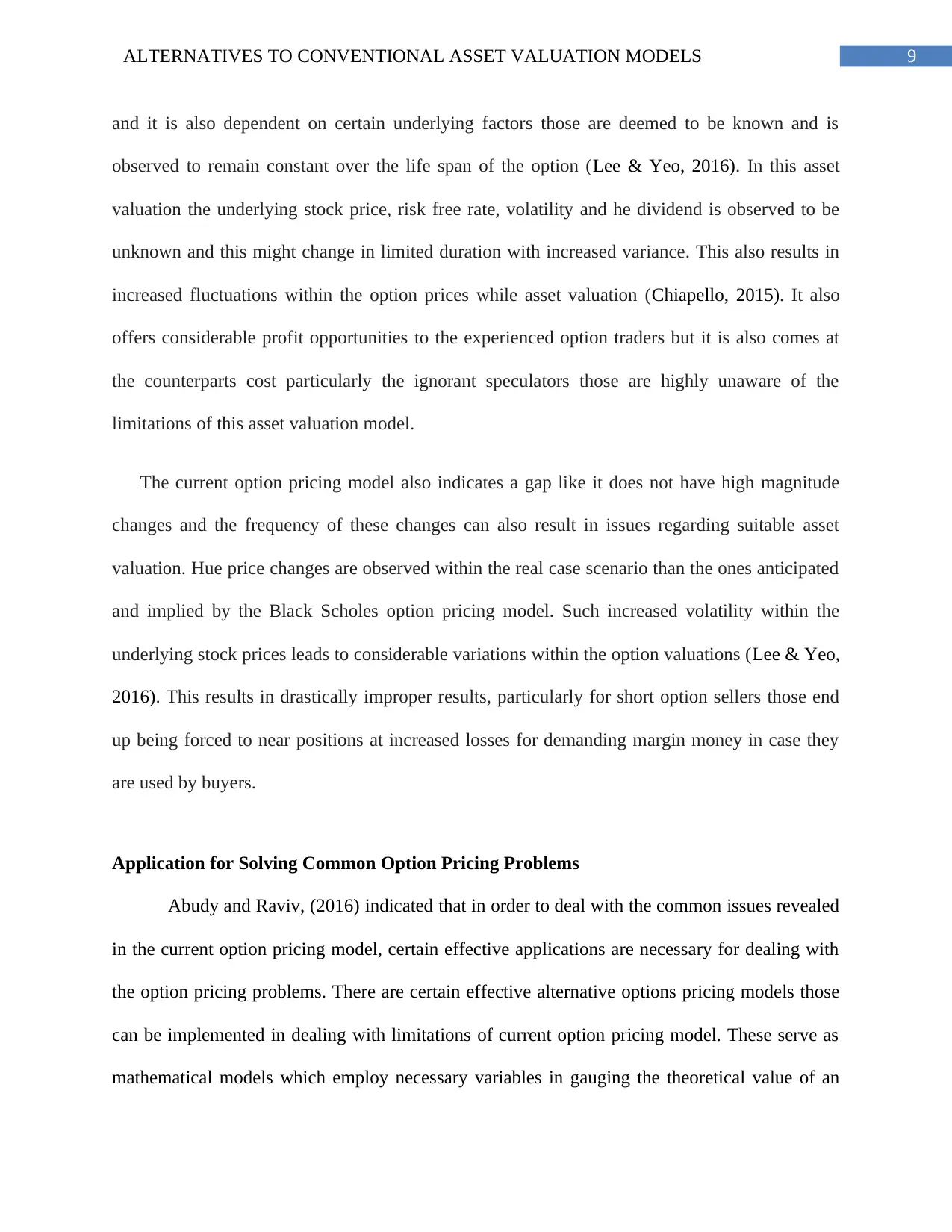
9ALTERNATIVES TO CONVENTIONAL ASSET VALUATION MODELS
and it is also dependent on certain underlying factors those are deemed to be known and is
observed to remain constant over the life span of the option (Lee & Yeo, 2016). In this asset
valuation the underlying stock price, risk free rate, volatility and he dividend is observed to be
unknown and this might change in limited duration with increased variance. This also results in
increased fluctuations within the option prices while asset valuation (Chiapello, 2015). It also
offers considerable profit opportunities to the experienced option traders but it is also comes at
the counterparts cost particularly the ignorant speculators those are highly unaware of the
limitations of this asset valuation model.
The current option pricing model also indicates a gap like it does not have high magnitude
changes and the frequency of these changes can also result in issues regarding suitable asset
valuation. Hue price changes are observed within the real case scenario than the ones anticipated
and implied by the Black Scholes option pricing model. Such increased volatility within the
underlying stock prices leads to considerable variations within the option valuations (Lee & Yeo,
2016). This results in drastically improper results, particularly for short option sellers those end
up being forced to near positions at increased losses for demanding margin money in case they
are used by buyers.
Application for Solving Common Option Pricing Problems
Abudy and Raviv, (2016) indicated that in order to deal with the common issues revealed
in the current option pricing model, certain effective applications are necessary for dealing with
the option pricing problems. There are certain effective alternative options pricing models those
can be implemented in dealing with limitations of current option pricing model. These serve as
mathematical models which employ necessary variables in gauging the theoretical value of an
and it is also dependent on certain underlying factors those are deemed to be known and is
observed to remain constant over the life span of the option (Lee & Yeo, 2016). In this asset
valuation the underlying stock price, risk free rate, volatility and he dividend is observed to be
unknown and this might change in limited duration with increased variance. This also results in
increased fluctuations within the option prices while asset valuation (Chiapello, 2015). It also
offers considerable profit opportunities to the experienced option traders but it is also comes at
the counterparts cost particularly the ignorant speculators those are highly unaware of the
limitations of this asset valuation model.
The current option pricing model also indicates a gap like it does not have high magnitude
changes and the frequency of these changes can also result in issues regarding suitable asset
valuation. Hue price changes are observed within the real case scenario than the ones anticipated
and implied by the Black Scholes option pricing model. Such increased volatility within the
underlying stock prices leads to considerable variations within the option valuations (Lee & Yeo,
2016). This results in drastically improper results, particularly for short option sellers those end
up being forced to near positions at increased losses for demanding margin money in case they
are used by buyers.
Application for Solving Common Option Pricing Problems
Abudy and Raviv, (2016) indicated that in order to deal with the common issues revealed
in the current option pricing model, certain effective applications are necessary for dealing with
the option pricing problems. There are certain effective alternative options pricing models those
can be implemented in dealing with limitations of current option pricing model. These serve as
mathematical models which employ necessary variables in gauging the theoretical value of an
Paraphrase This Document
Need a fresh take? Get an instant paraphrase of this document with our AI Paraphraser
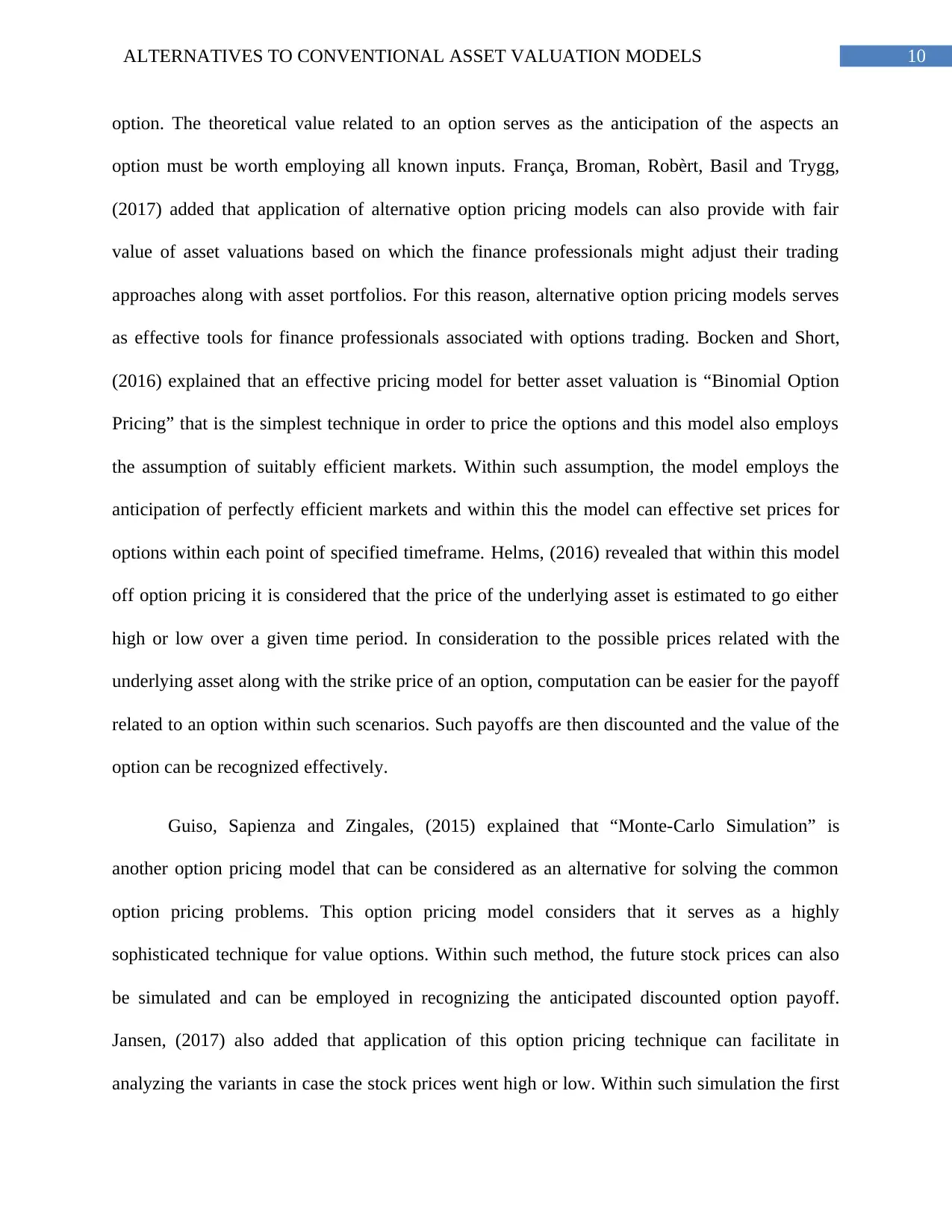
10ALTERNATIVES TO CONVENTIONAL ASSET VALUATION MODELS
option. The theoretical value related to an option serves as the anticipation of the aspects an
option must be worth employing all known inputs. França, Broman, Robèrt, Basil and Trygg,
(2017) added that application of alternative option pricing models can also provide with fair
value of asset valuations based on which the finance professionals might adjust their trading
approaches along with asset portfolios. For this reason, alternative option pricing models serves
as effective tools for finance professionals associated with options trading. Bocken and Short,
(2016) explained that an effective pricing model for better asset valuation is “Binomial Option
Pricing” that is the simplest technique in order to price the options and this model also employs
the assumption of suitably efficient markets. Within such assumption, the model employs the
anticipation of perfectly efficient markets and within this the model can effective set prices for
options within each point of specified timeframe. Helms, (2016) revealed that within this model
off option pricing it is considered that the price of the underlying asset is estimated to go either
high or low over a given time period. In consideration to the possible prices related with the
underlying asset along with the strike price of an option, computation can be easier for the payoff
related to an option within such scenarios. Such payoffs are then discounted and the value of the
option can be recognized effectively.
Guiso, Sapienza and Zingales, (2015) explained that “Monte-Carlo Simulation” is
another option pricing model that can be considered as an alternative for solving the common
option pricing problems. This option pricing model considers that it serves as a highly
sophisticated technique for value options. Within such method, the future stock prices can also
be simulated and can be employed in recognizing the anticipated discounted option payoff.
Jansen, (2017) also added that application of this option pricing technique can facilitate in
analyzing the variants in case the stock prices went high or low. Within such simulation the first
option. The theoretical value related to an option serves as the anticipation of the aspects an
option must be worth employing all known inputs. França, Broman, Robèrt, Basil and Trygg,
(2017) added that application of alternative option pricing models can also provide with fair
value of asset valuations based on which the finance professionals might adjust their trading
approaches along with asset portfolios. For this reason, alternative option pricing models serves
as effective tools for finance professionals associated with options trading. Bocken and Short,
(2016) explained that an effective pricing model for better asset valuation is “Binomial Option
Pricing” that is the simplest technique in order to price the options and this model also employs
the assumption of suitably efficient markets. Within such assumption, the model employs the
anticipation of perfectly efficient markets and within this the model can effective set prices for
options within each point of specified timeframe. Helms, (2016) revealed that within this model
off option pricing it is considered that the price of the underlying asset is estimated to go either
high or low over a given time period. In consideration to the possible prices related with the
underlying asset along with the strike price of an option, computation can be easier for the payoff
related to an option within such scenarios. Such payoffs are then discounted and the value of the
option can be recognized effectively.
Guiso, Sapienza and Zingales, (2015) explained that “Monte-Carlo Simulation” is
another option pricing model that can be considered as an alternative for solving the common
option pricing problems. This option pricing model considers that it serves as a highly
sophisticated technique for value options. Within such method, the future stock prices can also
be simulated and can be employed in recognizing the anticipated discounted option payoff.
Jansen, (2017) also added that application of this option pricing technique can facilitate in
analyzing the variants in case the stock prices went high or low. Within such simulation the first
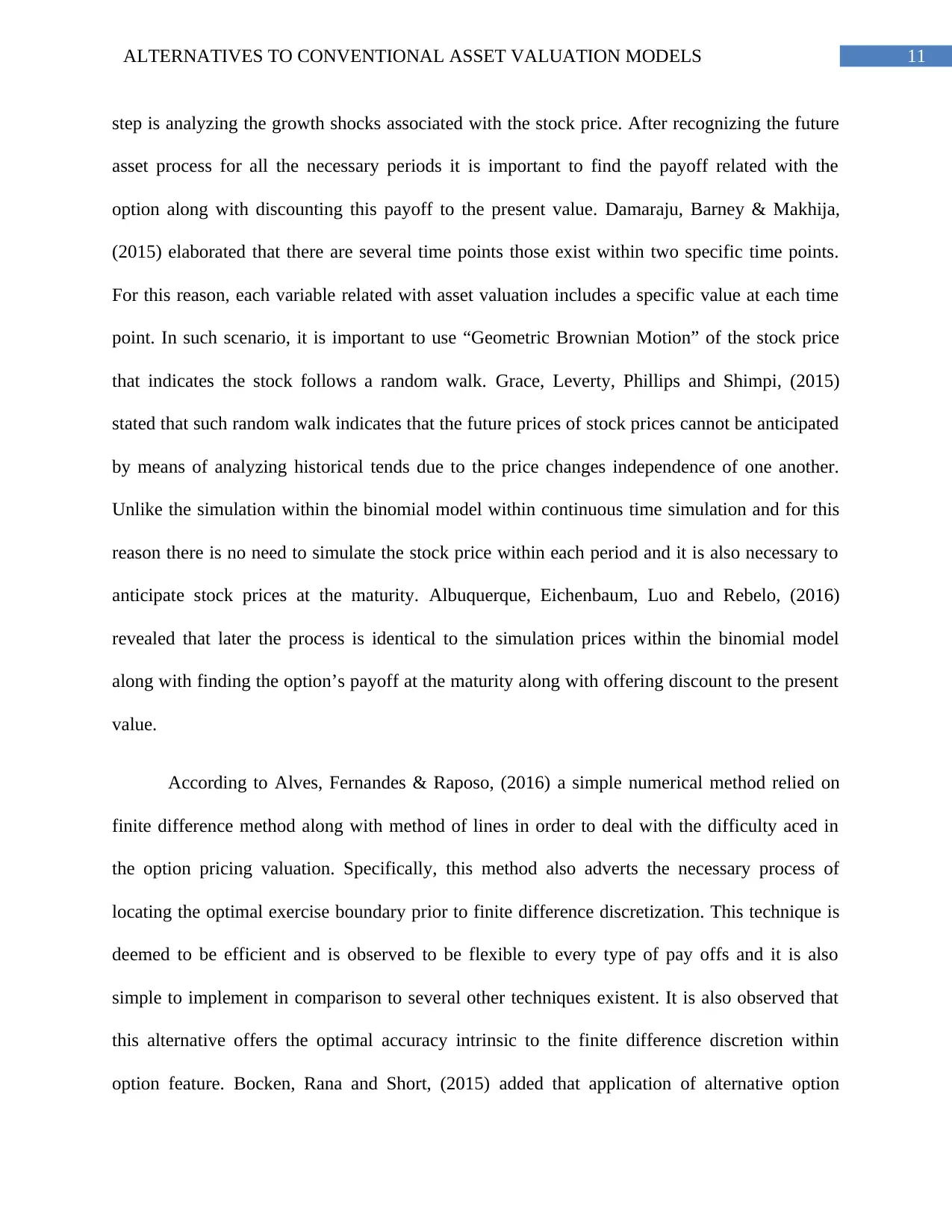
11ALTERNATIVES TO CONVENTIONAL ASSET VALUATION MODELS
step is analyzing the growth shocks associated with the stock price. After recognizing the future
asset process for all the necessary periods it is important to find the payoff related with the
option along with discounting this payoff to the present value. Damaraju, Barney & Makhija,
(2015) elaborated that there are several time points those exist within two specific time points.
For this reason, each variable related with asset valuation includes a specific value at each time
point. In such scenario, it is important to use “Geometric Brownian Motion” of the stock price
that indicates the stock follows a random walk. Grace, Leverty, Phillips and Shimpi, (2015)
stated that such random walk indicates that the future prices of stock prices cannot be anticipated
by means of analyzing historical tends due to the price changes independence of one another.
Unlike the simulation within the binomial model within continuous time simulation and for this
reason there is no need to simulate the stock price within each period and it is also necessary to
anticipate stock prices at the maturity. Albuquerque, Eichenbaum, Luo and Rebelo, (2016)
revealed that later the process is identical to the simulation prices within the binomial model
along with finding the option’s payoff at the maturity along with offering discount to the present
value.
According to Alves, Fernandes & Raposo, (2016) a simple numerical method relied on
finite difference method along with method of lines in order to deal with the difficulty aced in
the option pricing valuation. Specifically, this method also adverts the necessary process of
locating the optimal exercise boundary prior to finite difference discretization. This technique is
deemed to be efficient and is observed to be flexible to every type of pay offs and it is also
simple to implement in comparison to several other techniques existent. It is also observed that
this alternative offers the optimal accuracy intrinsic to the finite difference discretion within
option feature. Bocken, Rana and Short, (2015) added that application of alternative option
step is analyzing the growth shocks associated with the stock price. After recognizing the future
asset process for all the necessary periods it is important to find the payoff related with the
option along with discounting this payoff to the present value. Damaraju, Barney & Makhija,
(2015) elaborated that there are several time points those exist within two specific time points.
For this reason, each variable related with asset valuation includes a specific value at each time
point. In such scenario, it is important to use “Geometric Brownian Motion” of the stock price
that indicates the stock follows a random walk. Grace, Leverty, Phillips and Shimpi, (2015)
stated that such random walk indicates that the future prices of stock prices cannot be anticipated
by means of analyzing historical tends due to the price changes independence of one another.
Unlike the simulation within the binomial model within continuous time simulation and for this
reason there is no need to simulate the stock price within each period and it is also necessary to
anticipate stock prices at the maturity. Albuquerque, Eichenbaum, Luo and Rebelo, (2016)
revealed that later the process is identical to the simulation prices within the binomial model
along with finding the option’s payoff at the maturity along with offering discount to the present
value.
According to Alves, Fernandes & Raposo, (2016) a simple numerical method relied on
finite difference method along with method of lines in order to deal with the difficulty aced in
the option pricing valuation. Specifically, this method also adverts the necessary process of
locating the optimal exercise boundary prior to finite difference discretization. This technique is
deemed to be efficient and is observed to be flexible to every type of pay offs and it is also
simple to implement in comparison to several other techniques existent. It is also observed that
this alternative offers the optimal accuracy intrinsic to the finite difference discretion within
option feature. Bocken, Rana and Short, (2015) added that application of alternative option
⊘ This is a preview!⊘
Do you want full access?
Subscribe today to unlock all pages.

Trusted by 1+ million students worldwide
1 out of 19
Related Documents
Your All-in-One AI-Powered Toolkit for Academic Success.
+13062052269
info@desklib.com
Available 24*7 on WhatsApp / Email
![[object Object]](/_next/static/media/star-bottom.7253800d.svg)
Unlock your academic potential
Copyright © 2020–2025 A2Z Services. All Rights Reserved. Developed and managed by ZUCOL.



